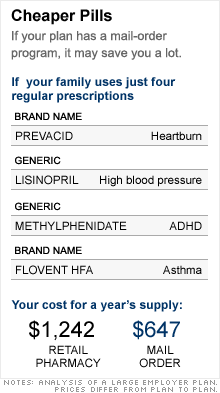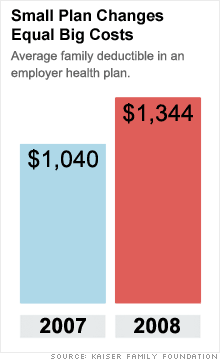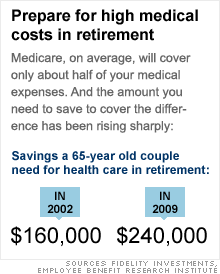10 ways to beat the rising cost of health care
Deductibles, co-pays, and drug prices keep going up, up, up. These 10 smart moves can lower your expenses - but not the quality of the care you get.
 |
| Carolyn Habryl, 53, of Sugar Land, Texas, cut costs for her cholesterol drug by over 90% by switching to generics and using mail order prescription services. |


 |
| Jennifer, 32, and Ari, 37, Armstrong of Westminster, Colo. shopped around for an individual policy with a high deductible, and contribute to a health savings account. They also ask for discounts in exchange for paying upfront. |

(Money Magazine) -- Talk about a recession double whammy. It's bad enough that you've been working harder with less prospect of getting a raise. Now it feels as if you can't even afford to get sick.
According to benefits consultant Hewitt, the average insured worker at a big company is likely to spend $3,826 on insurance premiums and out-of-pocket medical costs in 2009. That's up 9% from last year, a remarkable figure when you consider that inflation overall is pretty close to zero.
It seems that in good times and bad, you can count on health-care costs to defy economic gravity. And it doesn't get much better when you hit 65 and qualify for Medicare. By one estimate, a couple retiring this year will need a cool quarter-million in savings just for medical expenses.
So for better or worse, managing your own health care has become an essential part of financial planning. Washington is hotly debating how to fix our high-cost health-care system, but in the meantime there are some things you can do to lower your bills without compromising on care. Here are your best strategies for easing the pain.
Most of us still aren't used to the idea of talking money with a doctor. But you won't be shocking his delicate sensibilities. "The uninsured frequently ask for a discount or a payment plan, but most insured consumers don't realize that they can negotiate," says Ruth Levin of Continuum Health Partners, a New York City hospital system.
Negotiating is especially important if you have a big deductible, are using an out-of-network doc, or face a steep co-pay or co-insurance. Your doctor may be willing to charge less if you can pay upfront because it saves a billing hassle. Doctors and hospitals not in your insurer's network may still be willing to charge you in-network rates. And if you can't immediately cover a big bill, hold off on swiping your credit card. Providers often work out payment plans over many months without charging interest, says Levin.
You can also shop around. If you need a test or an operation, ask your doctor to recommend more than one facility. Your insurer may be able to tell you which provider will charge less. A few major insurers, such as Cigna, have websites that let their customers compare costs on common procedures such as CT scans. Of course, you don't want to base your decision on price alone. Check out your insurer's website or hospitalcompare.hhs.gov to see how well hospitals rate on quality control and patient outcomes.
Finally, ask about alternatives, says Davis Liu, a family doctor and the author of "Stay Healthy, Live Longer, Spend Wisely." For example, your doctor may suggest an MRI to figure out why your back is hurting. But if you push back a bit, she may also tell you that you can first try back exercises for a few weeks and see if the pain goes away on its own. It very often does.
Health plans have gotten picky about pills. About 77% of workers with a drug benefit face three or more price tiers - one cost for generics and higher charges for "preferred" and "nonpreferred" brands. If Prevacid isn't on your preferred list, it could easily cost you $300 a year more than a generic version of Prilosec.
Your doctor won't necessarily know your insurance rules. And although pharmacists may be able to switch you from a brand to the equivalent generic, they can't move you to a similar alternative drug without a new prescription. So you may need to do some research. Your insurer or your pharmacy benefit manager - that's the company listed on your prescription card - may have a website that lets you both price drugs and find alternatives with lower out-of-pocket costs. If your plan doesn't offer this, compare retail prices at drx.com. That's helpful if you usually pay a percentage of the cost.
You can also save by switching where you buy. Many prescription plans give you a big discount if you use their mail-order pharmacy. Some retail chains offer popular generics for just $4 for a 30-day supply.
Need any more proof that humans aren't as rational as economists assume? Look at flexible spending accounts, a benefit that can put hundreds of bucks in your pocket. About 80% of large employers offer FSAs, but a mere 22% of their workers enroll, according to the consultancy Mercer.
An FSA allows you to set aside part of your paycheck for health expenses. (The exact limit depends on your company, but it's usually $2,000 to $5,000.) You don't have to pay income or payroll taxes on that part of your earnings. So if you are in the 28% bracket, a $1,000 FSA may save you about $350. Money in your FSA can usually be used to cover co-pays and deductibles, prescriptions, and even over-the-counter drugs. These plans used to require paperwork, but that excuse is gone. Many now offer debit cards and websites to track and manage your spending.
There are still two little catches: First, you lose money you don't spend by year-end (or in the first months of the following year, again depending on your company). So use your bills from this year to estimate your expenses for next year. If a little is left over in December, you can stock up on Tylenol or buy an extra pair of glasses. Second, you can sign up only after a life change (a marriage, a baby) or during open-enrollment season, near the end of the year. So mark your calendar now.
Wish you could pay a lower monthly premium? Many firms offer you a choice between a traditional plan and one with low monthly costs but a much bigger annual deductible. But high-deductible plans aren't a good fit for everyone.
Before you switch, consider both your overall health and your ability to pay for the whole deductible. In general, if you are older or have a chronic condition, you're better off in a traditional plan, says Los Angeles financial planner Jennifer Hartman. But if your employer also offers to contribute a lot to your health savings account, that could tip the balance toward the high-deductible plan. And what is a health savings account? Read on.
If your family's insurance deductible is higher than $2,300 you likely qualify for a health savings account, or HSA. Like FSAs, these accounts let you save pretax dollars for health costs. The key difference is that you get to keep your money there as long as you want. And so long as you use it to buy health care, you don't pay taxes when you withdraw it either.
This year a family can contribute up to $5,950, while singles can put in $3,000. Those ages 55 to 65 can add another $1,000. Employers can help with contributions, and half that offer qualified plans do so. Come retirement, you can even spend the money on non-health-related items, although you'll pay taxes on it.
Your employer might recommend an HSA provider, or you can choose your own. "Shop around for the best rates and terms," says Hartman, the L.A. planner. Some HSAs offer debit cards you can use at the doctor's office or drugstore. Many even allow you to invest in mutual funds. But don't put any HSA money that you'll need within five years into anything but safe savings. Compare account terms at vimo.com/hsa. Note: You generally cannot have both an HSA and an FSA.
Physicians jam so many appointments into a day that it can be hard to squeeze in on short notice. And if you have to take your kid to an emergency room for a weekend illness, it could cost you a co-pay of $100 or more, especially if the insurer deems it a nonemergency. But there are easier, cheaper ways to get treatment for minor ailments.
First, workplace clinics are making a comeback. Most common at large companies, they are generally staffed with nurse practitioners, RNs with additional training and the ability to prescribe. You can swing by at lunch. The price: gratis.
Walk-in retail clinics in chain stores also rely on nurse practitioners. They're a good choice if you know what's wrong and it's simple. (If you aren't sure if you should go to a doctor instead, go to a doctor.) Prices for treating earaches, sore throats, and the like are posted on the wall. If your insurance pays, the co-pay is usually the same as a doctor's visit and a lot less than the ER.
For more serious problems, such as cuts that require stitches, consider an urgent-care clinic. They employ doctors but are typically still cheaper than ERs.
You already know that you should have a cash emergency fund that covers six months' expenses. That figure should include insurance costs, because you don't want to let coverage lapse. Not only would you be vulnerable to huge costs if you fell ill, but if you let coverage slide for 63 days or more, your next employer doesn't have to immediately cover preexisting conditions.
To figure out how much to set aside, ask your HR department what you'd have to pay to extend your benefits under the COBRA law. Companies with at least 20 employees typically must allow you to stay in your plan for up to 18 months. But you'll have to pay the premiums. The good news: If you lose your job before 2010, you may qualify for a federal subsidy that covers 65% of COBRA premiums.
That subsidy makes COBRA your best bet in almost any circumstance for now. But after it phases out, you may find that an individual plan is less expensive if you are young and healthy. Check out quotes on ehealthinsurance.com.
Employers want you to be healthier, and not because they love you. They're trying to control their health costs, says Kathy Harte, a consultant at Hewitt.
Today nearly 90% of large employers offer some type of wellness program, including help with losing weight or quitting smoking, according to the Kaiser Family Foundation. Your company may even pay you - or charge lower premiums - for participating. Other plans are offering free access to a health-care coach, typically a nurse, who can offer one-on-one help for managing a chronic condition.
Employers are considering the stick as well as the carrot. According to Hewitt, some 17% of big companies charge or plan to charge higher premiums to employees who engage in unhealthy behaviors such as smoking. Yup, they can do that.
Medicare has become a bit baffling. Besides traditional coverage, you can choose private plans called Medicare Advantage. And then there are all those new drug programs.
Here's how you can easily avoid a couple of big mistakes in the next open enrollment. First, don't go with a plan without checking to see if your pills are covered. (Use the formulary finder at medicare.gov to find a plan with your pills.) Second, if you split your time in different areas, only choose an Advantage plan with a provider network in both places. Or stick with traditional Medicare.
Your company may offer you optional vision benefits, which might seem pretty attractive. But run the numbers before you sign up. Add up the amount you spend on contacts, glasses, and optometrist visits each year. Then calculate how much you'd save with the plan's benefits. Some people find that the coverage costs about the same, or sometimes more, than they save. And remember, you can also pay for vision through your FSA or HSA.
Dental coverage is a better deal, but a third of employers don't offer it. In that case, consider a discount program through your health insurer or on sites like dentalplans.com. These give you 20% to 30% off at participating dentists and cost about $150 a year. Everything we said about negotiating a discount with doctors applies to dentists too. It's the No. 1 rule of 21st-century health care: You don't ask, you don't get. ![]()


